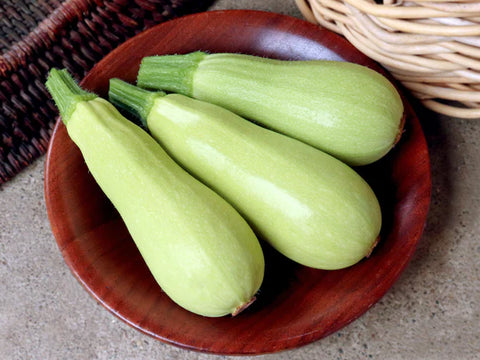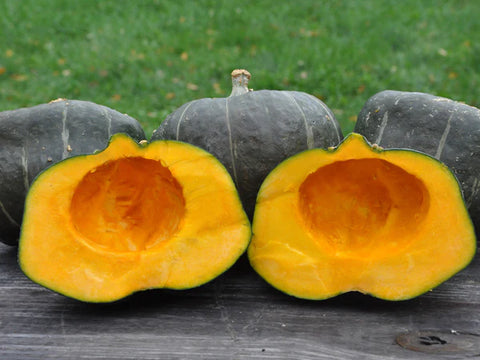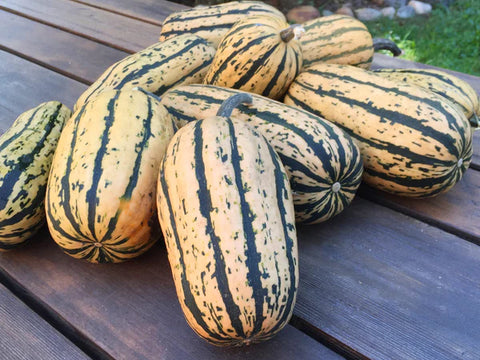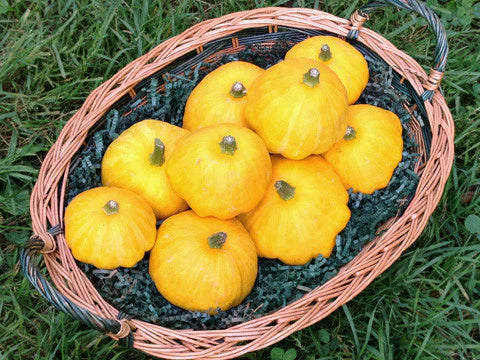Squash are easy to grow - seeds are easy to start outside! In this day and age, where you can get food whenever you want, squash is often underappreciated. However, our ancestors depended on squash and other storage crops for sustenance in the wintertime.
Pictured: Homs Kousa Squash (click for seeds)
Types of Squash
Squash are botanically considered fruit and are divided into two categories: Winter squash and summer squash. Both types of squash are planted simultaneously and grown throughout the summer. The difference is the harvest time; summer squash (such as zucchini) are immature squash – that is, they are harvested during summer when they are young and tender. Winter squash (such as Butternut, Butterbush, and Delicata) are harvested in the fall when fruits are mature and have a hard shell. They are stored and eaten through the wintertime and are generally sweeter than summer squash.
Pictured: Burgess Buttercup Winter Squash (click for seeds)
Why Grow Squash?
- They're tasty!
- They're nutritious!
- They're easy to grow – sow seeds directly outside into the soil!
- They're productive!
- When stored properly, winter squash can last through winter.
Tips for Growing Squash
Starting seeds:
- Sow squash seeds directly outside around June 1st for winter squash or between June 1st and June 15th for summer squash.
- Alternatively, start seeds indoors around May 1st into biodegradable pots.
- Transplant squash plants outside pot and all, any time after May 20th
- Seed planting depth: ½" depth
- Make sure to keep seeds moist (but not too wet!) until germination
Planting Using the Three Sisters Method:
The Three Sisters method is a sustainable gardening technique that involves interplanting corn, beans, and squash in the same mound. To use this method to plant squash, follow these tips:
- Plant corn, beans, and squash in "patches" 4 feet apart.
- Week one: plant corn (5-6 seeds, 2-3" apart)
- Weeks two - three (when corn is at least 5" tall): plant pole beans (4-5 seeds encircling corn)
- Week three: plant winter squash (5-6 seeds encircling beans)
- Thin seedlings to i. 2-3 corn plants ii. 2 pole beans iii. 3-4 squash plants per patch
🌱 Soil:
Squash plants grow best in nutrient-rich, well-drained soil with an optimal pH range of about 6.5 to 7. Organic matter will help increase the uptake of water and nutrients. Adding compost to the soil will make your squash very happy!
☀️ Light:
Plant squash in full sun. Squash plants need this full sun to produce, so they should be planted in an area with at least 6 hours of sunlight daily.
🌱 Spacing:
Vining squash ramble and take up a lot of space, while "bush" types can be grown in smaller areas and containers. See the "growing instructions" on our website and the back of our seed packets for the correct spacing of each squash variety.
💧 Water:
Be sure to water your squash plants several times per week! Squash plants need 1–2 inches of water per week, depending on the weather and soil conditions.
Pictured: Candystick Delicata Squash (click for seeds)
Instructions For Growing Squash
Starting squash seeds inside:
- Use biodegradable pots - as with all plants in the cucumber family; squash plants do not like their roots disturbed during transplanting. Plant the pot into the ground.
- The ideal temperature for germination is 85°- 95° (you may want to use a heating mat).
- Squash seedlings are sensitive to damping off fungus, so keep germinating seeds drier and use a fan (set to low) to provide air circulation.
- Once two leaves appear, grow plants at 72°.
- Do not let plants become potbound.
Pests
- Cucumber beetles, squash bugs, and vine borers: protect seedlings by covering them with row cover fabric at planting and leaving it on until plants are flowering.
- Deer and groundhogs: use repellents or fencing
Pictured: Gold Pattypan Summer Squash (click for seeds)
Harvesting Squash
Summer Squash: harvest when squash is young & tender – pick zucchinis frequently before they grow into monster-sized squash!
Winter Squash: leave squash to ripen on the vine as long as possible into early fall, but harvest them before temperatures drop below 50. If left outside past this point, they may become damaged and won't store properly.
Find detailed growing, harvesting, and seed-saving instructions for each variety on our website and on the back of each seed packet!
Pictured: Dark Star Zucchini (click for seeds)
Storing Squash
- Squash can store well, but storage life depends on the type of squash and method of storage. Follow these tips to store your squash.
- Store winter squash in a cool, dry spot (a cool basement will do).
- Ideally, winter squash should be stored in a place where the temperature is between 50⁰ and 60⁰F.
- Relative humidity should be between 60 and 70 percent.
Squash Recipes
Not sure what to do with your squash harvest? Squash are very versatile in the kitchen. Squash can be used as a gluten substitute in many recipes as well, so it's excellent for celiacs. Here are some examples of how you can use root vegetables after the harvest! Generally, most squash can be eaten steamed, sautéed, baked, roasted, stir-fried, or made into a soup or bisque.






